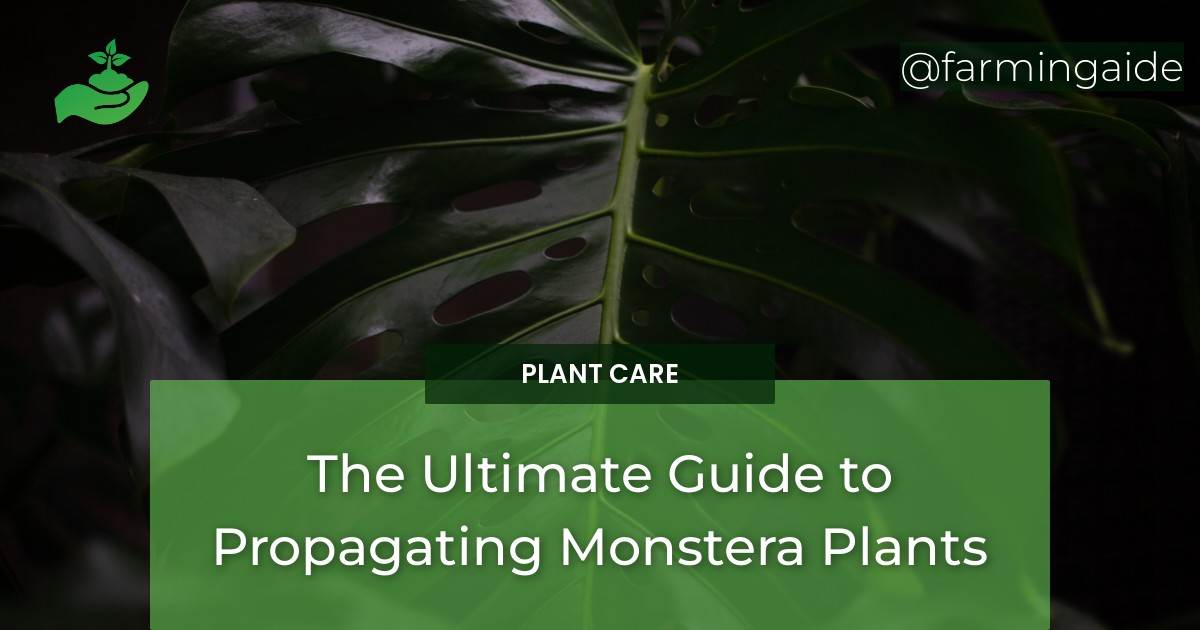The Ultimate Guide to Propagating Monstera Plants is a comprehensive resource for anyone looking to expand their collection of houseplants. Monstera plants, also known as Swiss cheese plants, are popular for their unique and striking foliage. Propagating these plants allows you to create new plants from existing ones, making it a cost-effective and rewarding way to grow your collection. In this guide, we will cover everything you need to know about propagating Monstera plants, from the benefits to the common mistakes to avoid. So, let’s dive in and learn how to successfully propagate Monstera plants.
Table of Contents
What is Monstera Plant?
Monstera plants are tropical plants native to the rainforests of Central and South America. They are known for their large, glossy leaves with unique holes and splits, giving them their nickname “Swiss cheese plant.” These plants are popular as houseplants due to their low maintenance and striking appearance.
Benefits of Propagating Monstera Plants
There are several reasons why propagating Monstera plants is beneficial:
- Cost-effective: Propagating Monstera plants allows you to create new plants from existing ones, saving you money on buying new plants.
- Expansion of collection: Propagating Monstera plants allows you to expand your collection of houseplants without having to purchase new ones.
- Control over plant quality: By propagating your own plants, you have control over the quality and health of the new plants.
Additionally, propagating Monstera plants can be a rewarding and enjoyable experience for plant enthusiasts.
How to Propagate Monstera Plants
Step 1: Choosing the Right Method
There are two common methods of propagating Monstera plants: stem cuttings and air layering. Each method has its own advantages and disadvantages, so it’s important to consider which one is best for your specific plant and situation.
Factors to consider when choosing a method include the size and health of the mother plant, the time and effort required, and the success rate of each method.
Step 2: Preparing the Plant
Before taking cuttings or layering, it’s important to identify a healthy and suitable mother plant. Look for a plant with strong and healthy leaves, free from any pests or diseases. It’s also important to prepare the plant by watering it a day before propagation to ensure it is well-hydrated.
ALSO READ
Step 3: Taking Cuttings or Layering
Once you have chosen the method, it’s time to take cuttings or layering. For stem cuttings, use a sharp and clean knife to cut a section of the stem just below a node. For air layering, make a small cut in the stem and wrap it with moist sphagnum moss and plastic wrap. Both methods require careful and precise techniques for success.
Some tips for success include taking cuttings from the top of the plant, using a rooting hormone, and making sure the cuttings or layering are secure and in place.
Step 4: Rooting the Cuttings or Layering
Rooting hormone is essential for successful propagation of Monstera plants. It helps stimulate root growth and increases the chances of success. Once the cuttings or layering have been treated with rooting hormone, they should be placed in a suitable medium, such as a well-draining potting mix or sphagnum moss. It’s important to keep the medium moist but not waterlogged.
ALSO READ
Step 5: Transplanting and Caring for New Plants
Once the cuttings or layering have rooted, they can be transplanted into their own pots. It’s important to provide proper care for the new plants, including adequate sunlight, water, and nutrients. Common mistakes to avoid during this stage include overwatering, using the wrong soil or pot, and neglecting pest and disease control.
Common Mistakes to Avoid
Overwatering
Overwatering is one of the most common mistakes when it comes to caring for Monstera plants. It can lead to root rot and other issues that can harm the plant’s health. To avoid overwatering, make sure to check the soil’s moisture level before watering and use well-draining soil.
Using the Wrong Soil or Pot
The type of soil and pot you use can greatly affect the success of propagating Monstera plants. It’s important to choose a well-draining soil mix and a pot that is the right size for the plant. A pot that is too large can lead to overwatering, while a pot that is too small can restrict root growth.
Neglecting Pest and Disease Control
Monstera plants are susceptible to pests and diseases, which can greatly affect their health and growth. It’s important to regularly check for any signs of pests or diseases and take appropriate measures to prevent and treat them.
Tips for Successful Propagation
- Choose a healthy and suitable mother plant.
- Provide optimal conditions for rooting and growth, such as adequate sunlight and water.
- Use rooting hormone for increased success.
- Know when your plant is ready for transplanting by checking for root growth.
How Can I Troubleshoot Common Issues When Propagating Monstera Plants?
When troubleshooting problems with monstera plants, check for yellowing or drooping leaves, which can be a sign of overwatering. Ensure proper drainage and consider adjusting watering frequency. Brown spots on leaves may indicate too much sunlight. Adjust to a shadier spot. Pests can also be a common issue, so inspect the plant regularly.
Conclusion
Propagating Monstera plants is a rewarding and cost-effective way to expand your collection of houseplants. By following the steps outlined in this guide and avoiding common mistakes, you can successfully propagate your own Monstera plants and enjoy their unique and striking foliage in your home. Remember to choose the right method, prepare the plant properly, and provide proper care for the new plants. With a little patience and care, you can become a successful Monstera plant propagator.


